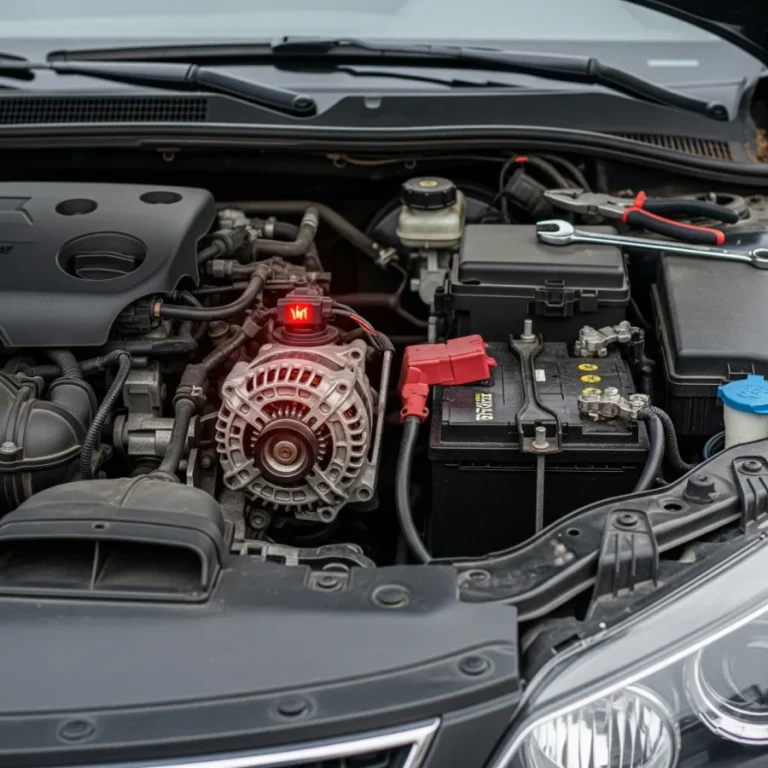How Long Can a Car Sit on a Flat Tire?
Walking out to your car and seeing it resting on a flat, lifeless tire is a frustrating sight. Your first thought might be, “Can I deal with this tomorrow?” but that delay can be a costly mistake. So, how long can a car sit on a flat tire before real damage sets in?
Let’s get right to it: A car should not sit on a flat tire for more than a day. Ideally, you should address it within a few hours to prevent permanent damage to the tire and wheel. The weight of your vehicle is an immense force, and that tire is not designed to support it without air pressure. This guide walks through exactly what happens when your car sits on a flat, the timeline for damage, and the precise steps you should take.
Key Takeaways
- Act Immediately: Do not let your car sit on a flat tire for more than 24 hours. Addressing it within a few hours is the best way to prevent permanent damage.
- Damage is Guaranteed: Leaving a car on a flat tire will permanently damage the tire’s sidewall, making a simple repair impossible.
- It’s More Than Just the Tire: The damage quickly extends to the metal wheel (rim), and over time can harm suspension components, alignment, and the delicate TPMS sensor inside the tire.
- Never Drive on a Flat: Driving even one mile on a flat tire can destroy the tire completely, damage the wheel, and lead to a loss of vehicle control.
- Your Best Options: Immediately install your spare tire. If you can’t, use a jack stand (not just a jack) to take the weight off the flat, or call for roadside assistance.
The Immediate Risk: A Quick Timeline of What’s Happening to Your Car
Time is your enemy when a tire is flat. The damage isn’t just a single event; it’s a chain reaction.
- First Few Hours: The tire’s internal steel and fabric cords begin to stretch and break under the vehicle’s weight. The flexible sidewall starts to crush and deform.
- After 24 Hours: Permanent tire damage is almost guaranteed. The wheel’s metal rim is now pressing directly on the rubber, and the tire is likely unseated from the bead, meaning it can’t just be pumped with air.
- A Week or More: You’re now risking expensive damage. The wheel itself can bend, and the prolonged uneven stance puts significant stress on your car’s suspension and alignment.
A Mechanic’s Breakdown: The Chain Reaction of Damage
To truly understand the urgency, you need to see the car from a mechanic’s perspective. The damage cascades from the tire to other expensive components.
I remember a customer once who left his sedan with a flat tire for nearly a week while he was away. He came into the shop expecting to just buy a new tire. Unfortunately, the entire weight of the car sitting on that flat had not only destroyed the tire but had also bent the lip of his aluminum alloy wheel and crushed the TPMS sensor flat. What should have been a straightforward $150 fix turned into a nearly $500 repair, all because of the delay. This is a firsthand example of how quickly the chain reaction of damage works.
Stage 1: Irreversible Tire Sidewall Damage
Think of the air in your tire as part of its structure. Without it, the sidewalls, which provide stability, collapse. The entire weight of one corner of your car—often over 1,000 pounds—presses down on the folded rubber. This action crushes the internal fabric and steel belts, causing permanent weaknesses.
Even if you reinflate it, the damaged sidewall will never be safe again. It’s also during this collapse that the tire’s bead (the edge that seals against the wheel) can pop off the rim. Once that seal is broken, the tire is useless until it’s professionally remounted, which is often impossible with a damaged sidewall. This is a far more serious issue than a simple bubble in the tire, which is already a sign of internal failure.
Stage 2: Costly Wheel and Rim Damage
Once the tire fully collapses, the load transfers directly to the metal wheel. The sharp edge of the rim is not designed to bear weight. Letting it sit, especially on a hard surface like asphalt or concrete, can easily cause scratches, gouges, or even bend the wheel.
A bent wheel won’t hold air properly and will cause vibrations when you drive. Repairing a wheel is expensive, and replacing a custom or high-end rim can cost hundreds of dollars. This is a completely avoidable expense.
Stage 3: Hidden Damage to Suspension and Alignment
Here’s the damage most people forget. Your car is engineered to sit perfectly level. When one corner sags on a flat tire, it creates an imbalance that puts continuous stress on other parts. The shocks, struts, and complex linkages of your suspension are pulled into an unnatural position.
Leaving it this way for days or weeks can strain bushings and damage the wheel bearing on that corner. You might fix the tire only to discover a new noise or a car that pulls to one side, meaning you now need to pay for an alignment or expensive suspension work on top of the new tire. If your vehicle has worn suspension, like needing the best shocks for a Chevy Tahoe, this added stress can accelerate its failure.
Stage 4: TPMS Sensor Damage
Inside your tire is a small, delicate Tire Pressure Monitoring System (TPMS) sensor. As required by the Federal Motor Vehicle Safety Standards, this sensor alerts you to low tire pressure. When the tire goes completely flat, this sensor can get pinned between the heavy wheel and the ground, crushing it instantly. A new TPMS sensor and the labor to install and program it can add another $50-$150 to your repair bill.
The Dangers of Driving on a Flat Tire (Even for “Just a Mile”)
What if you just need to move the car to a better spot? You should never drive on a flat tire unless you are moving a few feet to get out of a dangerous traffic lane.
Driving even a short distance destroys the tire’s sidewall completely, turning it into shredded rubber. More importantly, it makes the car incredibly difficult to control, and you risk the tire shredding apart and whipping into your fender or brake lines. You can take a $150 problem and turn it into a $2,000+ repair in less than a mile. Don’t do it.
Your Action Plan: What to Do When You Have a Flat Tire
Okay, you have a flat. Don’t panic. Follow these steps to handle it safely and correctly.
Step 1: Find a Safe, Level Parking Spot
If the tire went flat while driving, your first priority is safety. Get the car to a level spot away from traffic. Be aware that some jurisdictions have rules about how long a disabled vehicle can be left parked. For instance, some areas, like Fairfax County, VA, have specific parking restrictions you should be aware of.
Step 2: Try to Inflate It (If a Slow Leak)
If you have a portable air compressor, try to inflate the tire. If it’s a slow leak from a nail, you might be able to inflate it enough to drive slowly to the nearest tire shop. Listen for escaping air to judge how fast the leak is.
Step 3: Put on the Spare Tire
This is the best course of action. Your owner’s manual has instructions for your specific vehicle. Changing a tire is a great skill for any driver to have.
Step 4: Use a Jack Stand for Stability
What if you can’t install the spare right away? If you can safely lift the car with a jack, place a jack stand securely under the vehicle’s frame or a designated lift point. Then you can lower the car so its weight rests on the stand, taking the load off the flat tire entirely. Crucially, never leave a car supported only by a jack, as they can fail.
Step 5: Call for Roadside Assistance or a Mobile Tire Service
There is no shame in calling for help. Services like AAA or mobile tire repair companies can change your tire or even repair it on the spot. This is often the safest and most convenient option.
Your Pressing Questions Answered (FAQ)
These are the common questions drivers face when dealing with a flat. Let’s clear them up.
Is it okay to leave a flat tire overnight?
No, this is highly discouraged. While a single night might not destroy your metal rim, it is more than enough time to permanently ruin the tire itself. What could have been a simple $25 patch now becomes a full tire replacement, costing $150 or more. It’s just not worth the risk.
How is this different from long-term storage? Don’t tires get flat spots?
This is a great question. Flat spots and structural collapse are two very different things. Flat spots happen when a properly inflated tire sits in one spot for months, causing the part touching the ground to flatten temporarily. This often resolves itself after a few miles of driving.
A flat tire, however, is a complete structural failure. It’s related to the broader issue of tire aging, or “tire rot,” where the rubber compounds break down over time. According to safety documents from the NHTSA, rubber degrades from exposure and age, and letting a tire sit flat accelerates this process immensely.
How long can a car sit on a spare tire (donut)?
A “donut” spare is for emergencies only. Check the sidewall of the spare itself, but the universal rule is no more than 50 miles at a maximum speed of 50 mph. They are not designed for highway speeds or long-term use. Get to a tire shop as soon as possible.
Is it worse to let the car sit on just the rim?
Absolutely, yes. There is no scenario where this is acceptable. Sitting on the rim guarantees expensive damage to the wheel and puts extreme stress on the brake rotor, hub, and axle. Never let the vehicle’s weight rest on a bare rim.
Can a flat tire damage your suspension?
Yes. As we covered, the uneven load created by a flat tire puts prolonged, unnatural stress on your shocks, struts, and control arms. While a few hours won’t cause an issue, leaving it for days or weeks can lead to premature wear and failure of these critical components.
A Final Word of Advice
In the world of car maintenance, some issues can wait, and some can’t. A flat tire is one you need to address immediately. Acting fast protects your vehicle from a cascade of expensive and entirely preventable damage.
Remember, the cost of a new tire is a small price to pay compared to a new wheel, TPMS sensor, and suspension alignment. Protect your car and your wallet—take care of a flat tire right away.






